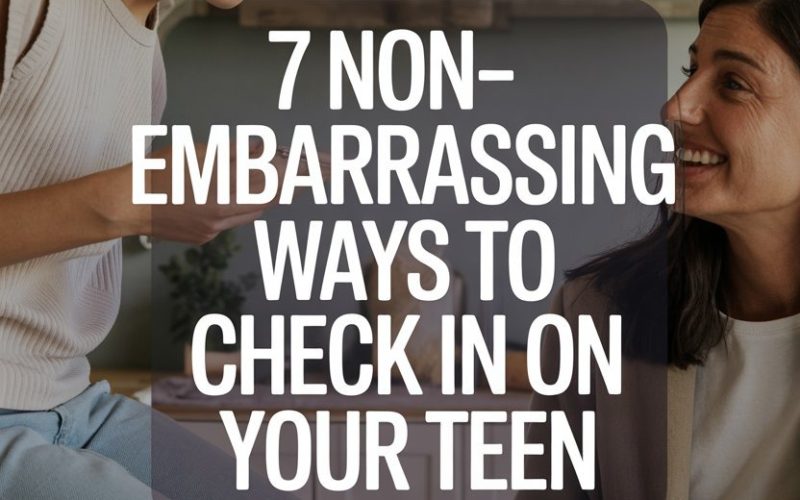Ever tried to ask your teenager how their day was and received a noise that sounded like a cross between a grunt and a dying Wi-Fi signal? Welcome to the club.
Checking in on teens can feel like you’re one emoji away from being the world’s most embarrassing parent.
But staying connected doesn’t have to mean invading privacy, interrogating at the dinner table, or—heaven forbid—sending a friend request on their main social account.
Below, you’ll find seven ways to genuinely check in on your teen that won’t leave either of you cringing.
1. Ask for Their Take on Current Events
Teens are famously allergic to “How was school?” but they’re surprisingly opinionated about what’s happening in the world.
Bring up a news story, viral video, or pop culture moment and ask what they think. Not as a quiz, but as if you’re genuinely curious (which, let’s face it, you probably are).
Research from the Family Dinner Project suggests that conversations sparked by real-world events, rather than direct questions about your child’s life, lead to richer discussions and more open communication.
Rather than grilling them about their math test, try, “Did you see that story about the influencer who raised a million pounds for charity? Is that all over your feed?”
You’ll get their take, and as a bonus, learn a little about their worldview—without ever uttering, “How was your day?”
2. Share Your Own Stories—The More Embarrassing, The Better
Sometimes the best way to get a teen to open up is to lower the stakes by sharing your own (mildly humiliating) stories.
Did you accidentally send a work email to the wrong person? Were you the last to realise that your jumper was on inside out during a meeting? Perfect. Teens love to see that adults are just as prone to awkwardness.
Psychologist Dr. Lisa Damour points out that self-disclosure helps build emotional bridges. When you admit your own mistakes, your teen feels less judged and more likely to share their own mishaps—without fearing a parental lecture.
The key here: keep it light, and let them laugh with you (not at you, if you can help it).
3. Develop a Ritual—But Make It Their Choice
Nothing says “I care” quite like a regular ritual, but skip the forced heart-to-heart on the sofa. Think smaller. Maybe it’s a weekly chippy tea, a brisk walk with the dog, or a once-a-week breakfast at that questionable pancake place.
The trick: let them help pick the ritual.
When teens get to choose, they feel respected—and you’re more likely to get genuine conversation over a plate of chips than during a scheduled “family meeting.”
Dr. Michael Thompson, a clinical psychologist specialising in adolescence, emphasises the power of routines in creating safe spaces for teens to open up.
The more low-key the ritual, the less pressure there is to talk, which, paradoxically, often leads to more conversation.
4. Communicate on Their Turf
Texting isn’t just for memes and cryptic one-letter replies. A quick message—“Picked up your favourite ice cream!” or “You’ll never guess what Nan said today”—shows you’re thinking of them, minus the intensity of face-to-face questioning.
Parenting expert Michelle Icard recommends using digital communication to keep the connection open, especially for teens who clam up in person.
Emoji-laden texts, silly GIFs, or even a meme war can go a long way in showing interest while respecting their space. Just promise not to use any slang you learned on Urban Dictionary unless you’re ready for some serious side-eye.
5. Ask Them to Teach You Something
Teens are experts in all sorts of things that make adults feel like they’re 112 years old. Whether it’s a trending TikTok dance, a new gaming strategy, or just why everyone suddenly cares about F1 racing, ask them to show you how it works.
A study from the University of California demonstrated that teens who teach their parents a skill develop increased confidence and are more likely to share their ideas and feelings.
Plus, letting your teen be the expert (and you the slightly clueless student) is a refreshing role reversal. You might even accidentally bond—just don’t blame anyone if you end up with a wonky viral dance video on your phone.
6. Use Errands and Car Rides as Stealth Chat Opportunities
Parents of teens quickly learn that eye contact and deep conversation rarely mix. Enter the beauty of parallel activities: driving, walking, folding laundry, or even queuing at the shop together.
When attention is divided and expectations are low, your teen might just start talking.
Clinical psychologist Dr. Laura Markham points out that side-by-side activities often work better than face-to-face chats for teens.
Without the pressure of intense focus, subjects that might be awkward or difficult can surface naturally. Try a casual “Anything interesting happen at college?” as you both stare out the windscreen.
No awkward silences, no pressure, just everyday connection.
7. Show Up for the Small Stuff
Big moments—performances, matches, awards—get all the attention, but the everyday “small stuff” matters more than most teens will ever admit.
They might not say much when you appear at the school play run-through, art show, or open-mic night, but they’ll notice.
Research from Search Institute finds that even older teens crave small acts of support from adults.
Consistently showing up, quietly cheering them on from the background, tells your teen you care about their interests, not just their grades or “achievements.”
You don’t have to be front and centre—sometimes being the quiet champion in the cheap seats is the best role.
Keeping the Door Open
Every parent wants to know what’s going on inside their teenager’s mind, but very few teens are keen to reveal all. The good news: you don’t need to interrogate, stalk, or become a TikTok influencer to stay connected.
A little creativity, some patience, and a willingness to show up (sometimes literally, sometimes just with a well-timed emoji) can make all the difference.
You may not get a full conversation every day, but these non-embarrassing check-ins build trust, foster connection, and remind your teen that you’re always in their corner—even if they only answer with a grunt (for now). Stick with it.
One day, they just might surprise you with more than a one-word reply. Or at the very least, a new meme.





